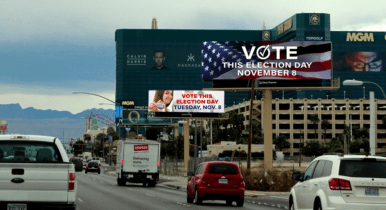The Billboard Creative Battle Is Coming to a Precinct Near You

This cycle will see a boom in out-of-home (OOH) advertising creative for a couple reasons. For starters, the medium, which includes everything from billboards to electronic bus shelter posters and top-of-taxi placements, is great for raising name ID, which any office holder finding themselves in a new district (because of redistricting) is going to need. The second is issues, of which this cycle has many ranging from high gas prices to inflation to abortion access.
The challenge, according to Lamar’s John Miller, a sales & marketing EVP, is creative copy writing. His advice: “Keep it short, keep it relevant and be flexible.”
“It’s not easy coming up with a simple message,” he told C&E. “There are times when we say, ‘we’d be stealing if we put this up.’”
That’s not to say all political OOH advertising needs to be dominated by copy. “I’ve seen some great ones with just copy. I’ve seen some great ones with just visual,” said Miller, whose company is the largest OOH U.S. provider in terms of panels and revenue.
Money is certainly moving toward the channel. Last cycle, political ad spending on OOH grew 65 percent from the previous presidential year. But if you’re still not convinced by the strategic imperatives of name ID and salient issue advertising, the Out of Home Advertising Association of America has some new data it wants to share.
The trade group recently commissioned a survey from The Harris Poll to measure the effectiveness of the medium and found that, at the very least, people report seeing these ads. In fact, 33 percent of respondents who said they planned to vote in the midterms reported seeing OOH political spots within the last week.
Another key finding of the survey was that young people reported being influenced by what they saw: 73 percent of Millennial respondents said they were influenced by OOH political ads, compared with 71 percent of Gen Zers and 49 percent of Gen X respondents. Now, Gen Zers (41%) were more likely to report that the OOH political spots increased awareness of an issue while Millennials (34%) said the ads generated interest to do more research.
One thing to consider with OOH creative is approvals. Miller said his company has sped up its approvals process, partly because digital placements now make up 2.5 percent of the company’s total inventory.
“We have a process: on any issue related copy, it’s goes through the local manager, and our local managers have a pretty good sense of what would be generally accepted in that community. Then it goes up the chain,” he said. “If it is at all sensitive, we have a process that it goes through so when it hits the street it’s gone through a pretty rigorous process [to determine whether] it will be accepted in this local market.”



